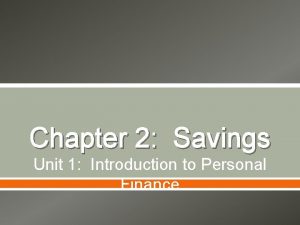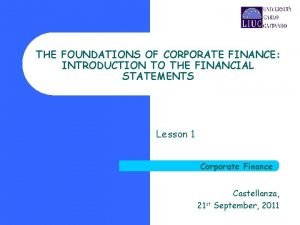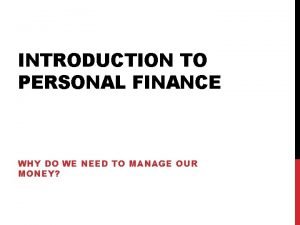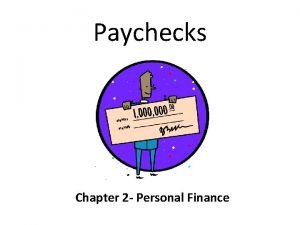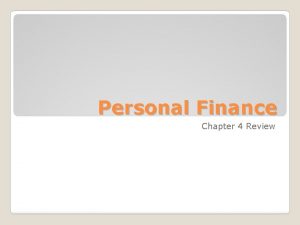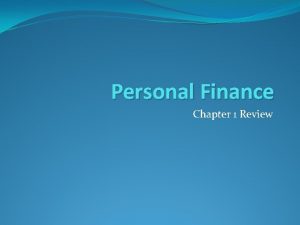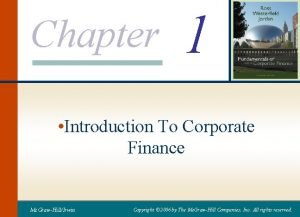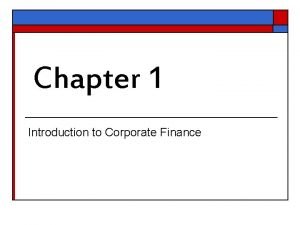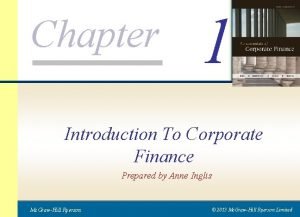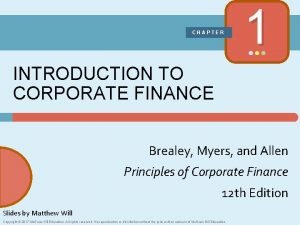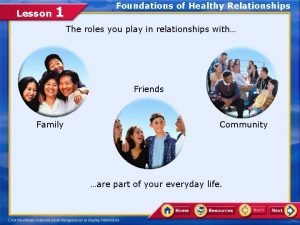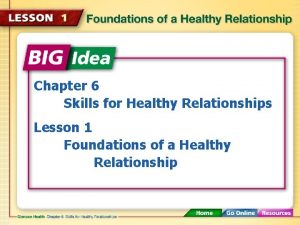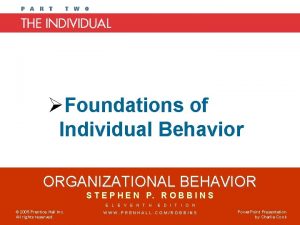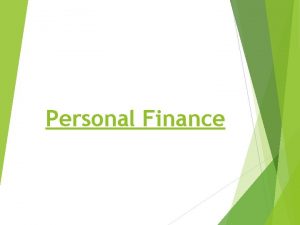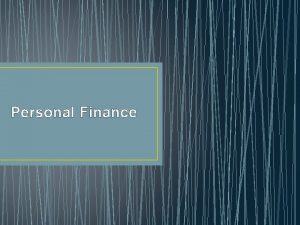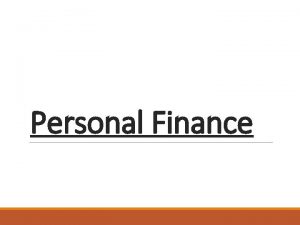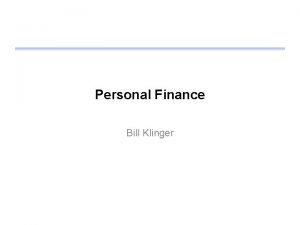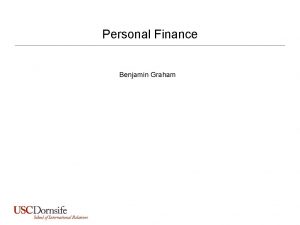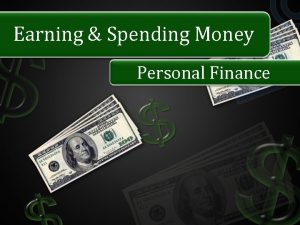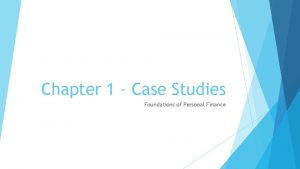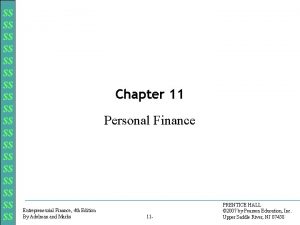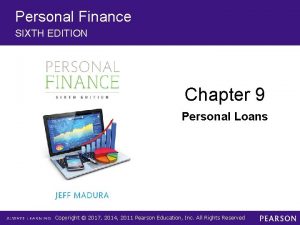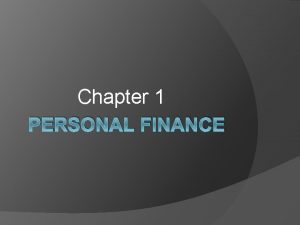Chapter 1 Foundations in Personal Finance Introduction to


















- Slides: 18

Chapter 1: Foundations in Personal Finance Introduction to Personal Finance

Explore Examine the charts, graphics, and reading excerpts in Chapter 1: Foundations in Personal Finance. o Make a list of questions you would like to have answered as we go through the chapter.

What Is Personal Finance? Section 1

Introduction WB: Before You Begin, pgs. 10 -11 o Review the Learning Outcome objectives and Key Terms o Complete the “Before” column on the “Measure Your Progress” chart Journal: 1. 2. 3. Can you think of a financial goal you have at this moment? Is this a long-term or a short-term goal? Describe how you plan to achieve this financial goal? Homework: Parent Interview Clay’s Candy Bar Madness (20 minutes)

Key Components of Financial Planning Video 1. 1 (13 minutes): Key Components of Financial Planning Journal: In what ways could you do better when it comes to managing your money?

Discussion Questions What is personal finance? o Personal finance is all the financial decisions an individual or family must make in order to earn, budget, save, and spend money over time. Why is it important to set money goals? o Setting money goals gives you motivation to manage your money well. In what ways are people different when it comes to managing money? o Everyone has different strengths and weaknesses when it comes to managing money.

Statistic Personal finance is 80% behavior and 20% knowledge Personal Finance Behavior Knowledge 20% 80%

Money, the American Way Section 2

A History of Credit and Consumerism Video 2. 1 (15 minutes): A History of Credit and Consumerism Journal: What was Dave’s biggest lesson when it came to managing money and building wealth?

Discussion Questions Why aren’t Americans better at managing money? Describe the financial reality of most Americans? o Many Americans are drowning in debt and buying things they can’t afford. What can you do to make sure your future financial reality does not include debt? o Have an emergency fund, write a monthly budget and stick to it, and save for large purchases.

Discussion Questions What was one thing that shocked you about the history of credit and consumerism? Did learning about the history of credit make you want to manage money differently than the average American? Why or why not? Why is Dave so passionate about teaching people how to manage money and avoid debt? In what ways are Americans being outsmarted by the credit industry?

Activity Activity: o History of Credit in America, (25 minutes)

You and Money Section 3

Learn the Language of Money Video 3. 1 (14 minutes): Learn the Language of Money

Discussion Questions Why is it important to know the language of money? o You need to know the language of money so you can understand your financial statements and communicate effectively about your finances. In what ways does your behavior affect whether or not you win with money? o Knowing how to manage money alone doesn’t ensure that you will manage your money behavior. It’s what you do with your money that matters most. What does it take to become money smart? o Basic math, understand the language of money, and manage your behavior with money.

Discussion Questions Describe three levels of financial well-being. o Survival: Living paycheck to paycheck o Comfort: Moving toward financial security o Secure: Your money works for you When you’re an adult, who will determine your level of financial well-being? o You will! Why is it important to consider your money personality when developing a personal financial plan? o Develop a plan that works with your specific money strengths and weaknesses.

Learn the Language of Money Read: o What’s your money personality? pg. 18 o What does winning with money look like? pg. 22 Activities: o foundations. U. com/1 • Money Personality Quiz o What is Personal Finance? (25 minutes) o Draw a picture representing each of the three levels of financial well -being. 1. 2. 3. Survival Comfort Secure

Chapter Summary foundations. U. com/1 o Article Summary: • Are Credit Cards a Way of Life? • Tired of Keeping Up with the Jones? • 20 Things Broke People Say Complete the “After” column on the “Measure Your Progress” chart, pg. 11. Chapter 1 Summary, pg. 24 -25 Study Guide: Money in Review, pgs. 26 -27
 Introduction to personal finance answers
Introduction to personal finance answers Five foundations of personal finance definition
Five foundations of personal finance definition Foundations of corporate finance
Foundations of corporate finance Personal finance lab
Personal finance lab Chapter 2 personal finance
Chapter 2 personal finance Personal finance 6th edition
Personal finance 6th edition Chapter 8 personal finance
Chapter 8 personal finance Chapter 4 post test personal finance
Chapter 4 post test personal finance Personal finance chapter 1
Personal finance chapter 1 Overview of personal finance chapter 1
Overview of personal finance chapter 1 Hotel industry foundations & introduction to analytics
Hotel industry foundations & introduction to analytics Chapter 1 introduction to corporate finance
Chapter 1 introduction to corporate finance Corporate finance chapter 1
Corporate finance chapter 1 Chapter 1 introduction to corporate finance
Chapter 1 introduction to corporate finance Chapter 1 introduction to corporate finance
Chapter 1 introduction to corporate finance What are the three c's of healthy relationships
What are the three c's of healthy relationships Chapter 6 skills for healthy relationships
Chapter 6 skills for healthy relationships Chapter 2 the nursing assistant and the care team
Chapter 2 the nursing assistant and the care team Chapter 2 foundations of individual behavior
Chapter 2 foundations of individual behavior

